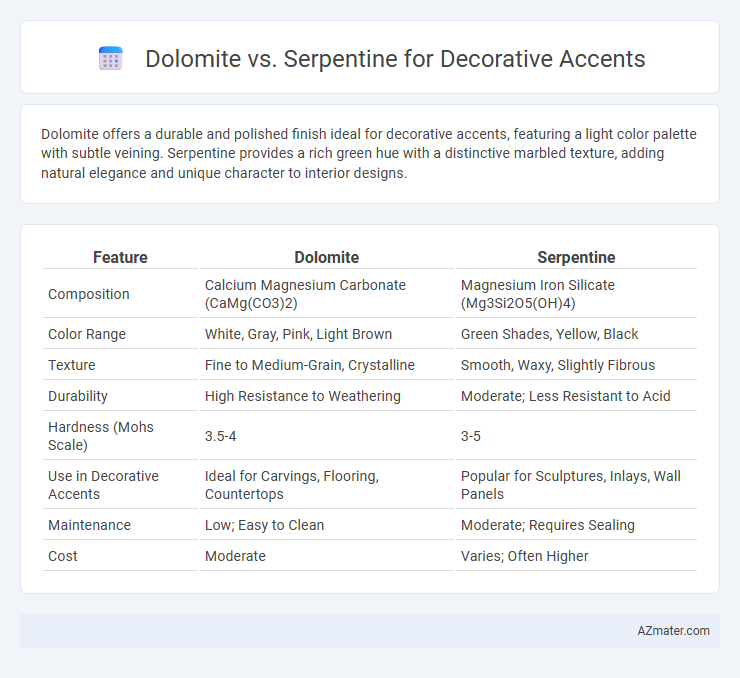Dolomite offers a durable and polished finish ideal for decorative accents, featuring a light color palette with subtle veining. Serpentine provides a rich green hue with a distinctive marbled texture, adding natural elegance and unique character to interior designs.
Table of Comparison
| Feature | Dolomite | Serpentine |
|---|---|---|
| Composition | Calcium Magnesium Carbonate (CaMg(CO3)2) | Magnesium Iron Silicate (Mg3Si2O5(OH)4) |
| Color Range | White, Gray, Pink, Light Brown | Green Shades, Yellow, Black |
| Texture | Fine to Medium-Grain, Crystalline | Smooth, Waxy, Slightly Fibrous |
| Durability | High Resistance to Weathering | Moderate; Less Resistant to Acid |
| Hardness (Mohs Scale) | 3.5-4 | 3-5 |
| Use in Decorative Accents | Ideal for Carvings, Flooring, Countertops | Popular for Sculptures, Inlays, Wall Panels |
| Maintenance | Low; Easy to Clean | Moderate; Requires Sealing |
| Cost | Moderate | Varies; Often Higher |
Introduction to Decorative Stones: Dolomite and Serpentine
Dolomite and serpentine are popular decorative stones valued for their unique textures and color variations. Dolomite features a crystalline structure with shades of white, gray, and pink, providing a versatile and elegant accent for interiors and exteriors. Serpentine is known for its rich green hues and smooth, often fibrous appearance, making it ideal for creating striking contrast and natural beauty in decorative applications.
Geological Origins: Dolomite vs Serpentine
Dolomite originates primarily from sedimentary carbonate rock formations rich in calcium magnesium carbonate, typically formed through diagenetic processes in marine environments. Serpentine, on the other hand, is a metamorphic rock derived from the alteration of ultramafic rocks like peridotite in subduction zones, resulting in a characteristic greenish hue and fibrous texture. Understanding these geological origins highlights dolomite's sedimentary clarity versus serpentine's metamorphic complexity, influencing their decorative accent applications and durability.
Physical Appearance: Color, Texture, and Patterns
Dolomite typically showcases a creamy white to light gray color with subtle pink or reddish hues, featuring a smooth, crystalline texture that enhances its refined appearance as a decorative accent. In contrast, serpentine displays rich green to dark green shades with mottled, veined, or speckled patterns, often including streaks of yellow or black that add an exotic, natural complexity. The distinct color palettes and textures of dolomite and serpentine influence design aesthetics, with dolomite offering elegant simplicity and serpentine providing vibrant, intricate visual interest.
Durability and Hardness: Which Stone Lasts Longer?
Dolomite, with a Mohs hardness of 3.5 to 4, offers superior durability compared to serpentine, which typically rates between 2.5 and 4, making dolomite more resistant to scratches and wear in decorative accents. Its denser crystalline structure provides enhanced longevity and better resistance to weathering, ideal for areas exposed to regular contact or outdoor conditions. Serpentine's lower hardness and porosity may result in quicker degradation, especially in high-traffic or moisture-prone environments, limiting its long-term durability.
Maintenance Requirements: Care Tips for Dolomite and Serpentine
Dolomite requires regular sealing to prevent staining and maintain its polished appearance, along with gentle cleaning using pH-neutral cleaners to avoid surface damage. Serpentine, known for its susceptibility to etching and scratching, demands frequent sealing and soft cloth wiping to preserve its vibrant color and smooth texture. Both stones benefit from avoiding acidic or abrasive substances to extend their decorative life and maintain aesthetic appeal.
Popular Decorative Uses: Home and Garden Accents
Dolomite and serpentine are both popular choices for decorative accents in home and garden settings due to their unique textures and colors. Dolomite, with its creamy white to pink hues and fine crystalline structure, is often used for elegant indoor countertops, tiles, and garden pathways, providing a classic, polished look. Serpentine's rich green shades and intricate patterns make it ideal for striking garden sculptures, fountains, and accent walls that bring a natural, vibrant touch to outdoor and indoor spaces.
Cost Comparison: Budgeting for Dolomite vs Serpentine
Dolomite generally costs less than serpentine, making it a more budget-friendly choice for decorative accents without compromising durability. Serpentine's higher price reflects its distinctive patterns and richer color variations, often preferred for premium designs. When budgeting, factor in installation and maintenance costs, as both materials require similar care but dolomite's lower initial price offers better value for budget-conscious projects.
Environmental Impact: Sourcing and Sustainability
Dolomite, primarily mined through quarrying, has a moderate environmental footprint with potential habitat disruption and carbon emissions tied to extraction and processing, yet it is considered relatively abundant and thus somewhat sustainable when sourced responsibly. Serpentine, often obtained via mining in limited geographic regions, may pose environmental concerns due to asbestos content risks and less widespread availability, raising challenges for sustainable sourcing practices. Choosing between dolomite and serpentine for decorative accents involves assessing the balance of ecological impact, availability, and health considerations associated with each stone's extraction and lifecycle.
Design Trends Featuring Dolomite and Serpentine
Dolomite and serpentine stand out as popular choices in contemporary decorative accents due to their distinct textures and vibrant color palettes. Dolomite's creamy whites and soft pinks align with minimalist and Scandinavian design trends, offering a subtle yet luxurious aesthetic. Serpentine's deep greens and dynamic veining cater to biophilic design themes, enhancing spaces with natural elegance and a bold statement.
Choosing the Right Stone: Factors to Consider
When selecting between dolomite and serpentine for decorative accents, consider durability, color range, and maintenance requirements. Dolomite offers a harder surface and often brighter, more consistent coloration, making it ideal for high-traffic areas and polished finishes, while serpentine's softer texture and unique veining provide a more natural, varied aesthetic suitable for low-impact spaces. Assessing environmental exposure, desired visual effect, and long-term wear ensures the right stone complements both function and style.

Infographic: Dolomite vs Serpentine for Decorative Accent
 azmater.com
azmater.com